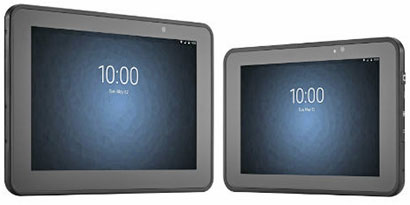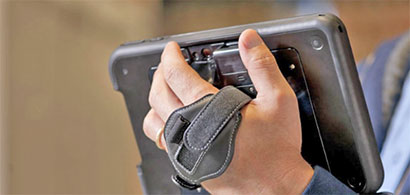|
Zebra ET50/55 Enterprise Tablet
Business-oriented, enterprise-class tablets come in two sizes and with Windows or Android
(by Conrad H. Blickenstorfer)
On September 15, 2015, Zebra introduced their next-generation ET50 and ET55 enterprise tablet computers. With these two new products, available with a 8.3-inch or 10.1-inch display size and with either Windows 8.1 or Android 5.1, Zebra sought to combine the best of consumer-styling with the kind of enterprise-class features required to increase workforce productivity.

Before we get into a brief discussion, here's the basic information on the two new tablets: Both are fashionably slender, just half an inch. The 10.1-inch version has a footprint of 10.6 x 7.1 inches, the smaller 8.3-inch model one of 9.0 x 5.9 inches. The larger weighs 1.55 pounds, the smaller 1.2 pounds. Those specs make them a bit larger and heavier than corresponding consumer tablets, but not by much.
Both displays have full 1080p 1920 x 1080 pixel resolution. That means 218 dots per inch for the larger screen (like an iMac 5k), and 262 dpi (like the iPad Air 2) for the smaller one. That's very sharp. The displays are bright enough as well. The smaller screen's backlight offers 440 NIT luminance, the larger 350 NIT. That about straddles the iPad Air 2, and is much brighter than your average consumer notebook. Both, of course, use 10-point capacitive multi-touch. Both also come with an active pen, though Zebra's specs don't say what kind. For now, an active pen offers much better precision than capacitive pens or finger touch for annotating, doodling and manipulating small checkboxes, scrollers, etc.
Zebra emphasizes the merging of features and concepts that appeal to consumers as well as the enterprise. But, obviously, the ET50 and 55 were designed from the ground up for enterprise and vertical market applications. That means:
- A size and weight manageable enough for workers to carry the tablets around all day.
- Inherent ruggedness — the ET50/55 can handle multiple drops, vibration, it has a wide-enough operating temperature range (32 to 122 degrees Fahrenheit), and it's generally built to the same ruggedness standards as Zebra's other ruggedized handhelds. And the display is protected by Corning's Gorilla Glass 3. Of note: if the standard 3-foot drop spec isn't enough, Zebra offers a "rugged frame" that doubles the drop spec to six feet.
- Security — there are different security requirements than for consumer tablets; the ET50/55 has 256-bit security, multi user logins, download control, etc., to keep credit card and other confidential data secure, both on-board and on removable media.
- Convenience — the batteries last a full shift, and there's an optional external battery that allows hot-swapping; there are various carry straps; a special expansion back system accommodates snap-on peripherals; and there's an array of accessories to expand and customize functionality.
- Data capture — the ET50/55's 8-megapixel rear camera supports 1D/2D scanning. For enterprise-class scanning, expansion packs can accommodate the Zebra SE4710 or Zebra SE4750 scan engines.
Below is a look at the tablet equipped with a handstrap and expansion back.

What do these new tablets mean for Zebra? Is the company on the right track? The answer remains somewhat elusive. There have been numerous enterprise tablet launches over the past several years, both Windows and Android based, and in a variety of sizes and configurations. But even after hundreds of millions of consumer tablets have been sold, it remains unclear if the enterprise demands special tablets or if inexpensive, easily replaceable consumer tablets in a cheap case are enough.
From a technology point of view, the ET50/55 is definitely on target. While in the past vertical market manufacturers argued that consumer tablet advances (like the hugely popular capacitive multi-touch) were not suitable or desirable for vertical applications, today's enterprise tablets are up to par in terms of the latest consumer tech. The ET50/55 includes competent quad-core Intel processors (we estimate the "Bay Trail" J1900 for the Windows and the E3845 for the Android version, Zebra specs don't say), those sharp displays, dual multi-function cameras (1080p front, 8mp rear), HDMI output, sensors (motion, gyro, light, e-compass), connectivity (USB, expansion port, microSDXC card slot) and wireless (Bluetooth, WiFi, autonomous GPS).
From what we can tell, the difference between the ET50 and ET55 model is not the display size nor the OS installed, but the inclusion of mobile broadband. The ET55 has global LTE with HSPA+. In North America, that means multi-carrier LTE with both Verizon (EVDO) and AT&T (HSPA+) 3G fallback.
Now what about the availability of both Windows and Android for both screen sizes? That's probably a good idea. While the Apple iOS and Android totally dominate the smartphone market, Windows is quite strong in the industrial and enterprise tablet markets. Initially it looked like Android may take that market over, too, but as of late we've seen considerable Windows strength.
What's different between the Windows and Android versions? Android has somewhat lower resource requirements, and so the Android version has a 1.9GHz Intel quad-core processor, 2GB of RAM and 32GB of eMMC Flash, whereas the Windows version comes with the 2.4GHz quad-core processor, 4GB of RAM, and 64GB of Flash. On the software side, Android includes a few extra "Mobility DNA" solutions, including StageNow (easy staging of multiple devices via barcode or NFC), EMDK (complements Google's Android SDK with enterprise functions), an Enterprise Browser, and AppGallery, which is Zebra's dedicated Android enterprise app store. There are also Zebra's Mobility Extensions (Mx) that add enterprise-class security, device management, data capture capabilities and more.
When the Motorola Solutions introduced the ET50/55's original ET1 ancestor in 2011, it was positioned as the company's first new era, post PC enterprise-oriented tablet (see our analysis of the 2011 ET1). But in the past, Symbol (which was bought by Motorola Solutions, part of which was bought by Zebra) had often been ahead of its time, and that perhaps applied to the ET1 as well.
We don't know how successful the somewhat futuristic ET1 was, but based on all that good "Mobility DNA," a clearer idea of the tablet market, and a somewhat more conventional design, the new ET50/55 Zebra tablets may well address the pent-up demand for a good enterprise tablet. And, if the price is right, attract quite a few enterprise customers.
|



